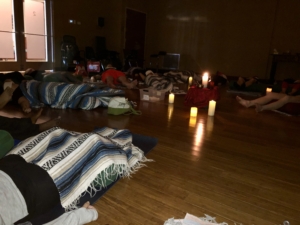
Yoga Nidra means yogic sleep, but the purpose of this powerful form of yoga is not to fall asleep. Using this unique guided meditation, you will be able to achieve deep, healing relaxation and find more balance and peace in your life.
Who Should Practice Yoga Nidra?
Everyone!
Most of us live busy, hectic lives and face chronic stress in our jobs, family life and as we fight rush hour traffic on our commute to work or speed on the roadsto make it to our kids’ soccer game or dance recital on time. Yoga Nidra is the perfect anecdote to this rushed, stressful lifestyle that many of us experience each day.
 No matter what your age or fitness level, you can benefit from this practice – from children to seniors. Yoga Nidra is beneficial for everyone, especially people who are suffering from depression, Post Traumatic Stress Disorder, addictions, insomnia, anxiety or those who simply want to de-stress. The Yoga Nidra session can be tailored to your specific goals. Most people who practice Yoga Nidra say they feel more open, free and relaxed afterwards.
No matter what your age or fitness level, you can benefit from this practice – from children to seniors. Yoga Nidra is beneficial for everyone, especially people who are suffering from depression, Post Traumatic Stress Disorder, addictions, insomnia, anxiety or those who simply want to de-stress. The Yoga Nidra session can be tailored to your specific goals. Most people who practice Yoga Nidra say they feel more open, free and relaxed afterwards.
How Do I Do It?
You simply lie on your back in stillness with your arms and legs extended in front of you as you would in “Savasana,” the final resting pose in yoga class. If lying on the floor is not comfortable for you, you can practice in a seated position. As you rest comfortably with your eyes closed, you listen to your teacher’s voice as you tune in to the sensations of your body and breath. You can also be guided by a voice on an audio recording.
What Are the Benefits of Yoga Nidra?
To the outside observer, it might appear that you are just sprawled out on the floor napping, but there is a lot going on deep down inside you that the eye cannot see.
Yoga Nidra is a state of consciousness that is between waking and sleeping where you are aware and alert. In this sleep-like state, you can experience a number of benefits:
- Deeply relax and let go of tension and worries that are stored in the physical body.
- Rebalance the nervous system by turning off your “fight or flight” response and activating the parasympathetic nervous system.
- Reduce fatigue and stress, so you feel more rested and rejuvenated.
- Open up blocked energy or “prana” in your body, which often brings emotions and sensations to the surface. After these sensations subside, your energy flows through you more freely, so you feel lighter, more peaceful and calmer.
- Calm the hyper-busy mind and create a sleep-like mental state that is fertile ground for positive changes to occur.
- Start to break negative thought patterns and habits called “samskaras” and replace them with powerful, positive intentions.
It has been shown that 30 to 40 minutes of Yoga Nidra can provide the same physical benefits of 2 to 3 hours of regular sleep.
No matter why you choose to do Yoga Nidra, the ultimate purpose is to help you live a happier, more fulfilled and balanced life. Contact Angela for more details and find out how you can integrate this simple but powerful practice into your life.
